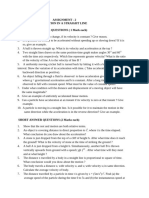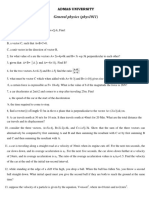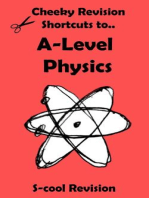Final Problem Set 1
Uploaded by
abel maestradoFinal Problem Set 1
Uploaded by
abel maestradoPROBLEM SET (RECTILINEAR AND CURVILINEAR MOTION)
NAME: DATE:
SECTION: SCORE:
1. A particle moves along a straight line with an acceleration of a = 5 / (3s1/3+s1/5) m/s2, where s is in
meters. Determine the particle’s velocity when s = 2 m, if it starts from rest when s = 1 m.
2. A particle travels along a straight line with a constant acceleration. When s = 4 ft, v = 3 ft/s and when
s = 10 ft, v = 8 ft/s. Determine the velocity as a function of position.
3. A particle is moving with a velocity of v0 when s = 0 and t = 0. If it is subjected to a deceleration of
a = -kv3, where k is a constant, determine its velocity and position as functions of time.
4. A particle is moving along a straight line such that its acceleration is defined as a = (-2v) m/s2, where v
is in meters per second. If v = 20 m/s when s = 0 and t = 0, determine the particle’s position, velocity,
and acceleration as functions of time.
5. The acceleration of a particle traveling along a straight line is a = (1/4 s1/2 ) m/s2, where s is in meters.
If v = 0, s = 1m when t = 0, determine the particle’s velocity at s = 2m.
6. A particle starts from s = 0 and travels along a straight line with a velocity v = (t 2 - 4t + 3) m/s, where t
is in seconds. Construct the v–t and a–t graphs for the time interval 0 ≤ t ≤ 4 s.
7. If the position of a particle is defined by s = [2 sin (π/5)t + 4] m, where t is in seconds, construct the s-
t, v-t, and a-t graphs for 0 ≤ t ≤ 10 s.
8. The velocity of a car is plotted as shown in the figure at the right.
Determine the total distance the car moves until it stops (t = 80 s).
Construct the a–t graph.
9. The velocity of a particle is v = { 3i + (6 - 2t)j } m/s, where t is in seconds.
If r = 0 when t = 0, determine the displacement of the particle during the
time interval t = 1 s to t = 3 s.
10. The velocity of a particle is given by v = {16t2 i + 4t3 j + (5t + 2) k} m/s, where t is in seconds. If the
particle is at the origin when t = 0, determine the magnitude of the particle’s acceleration when
t = 2 s. Also, what is the x, y, z coordinate position of the particle at this instant?
11. The position of a crate sliding down a ramp is given by x = (0.25t 3) m, y = (1.5t2) m, z = (6 − 0.75t5/2) m,
where t is in seconds. Determine the magnitude of the crate’s velocity and acceleration when t = 2 s.
12. The ball at A is kicked with a speed vA = 80 ft/s and at an
angle ϴA = 30°. Determine the point (x, –y) where it strikes the
ground. Assume the ground has the shape of a parabola
as shown.
13. A golf ball is struck with a velocity of 80 ft/s as shown.
Determine the speed at which it strikes the ground at B
and the time of flight from A to B.
# 13
14. The automobile is originally at rest at s = 0. If its speed is
increased by 𝑣̇ = (0.05t2) ft/s2, where t is in seconds, determine the magnitudes of its velocity and
acceleration when t = 18 s.
15. The car travels along the circular path such that its speed is increased by
at = (0.5et) m/s2, where t is in seconds. Determine the magnitudes of its
velocity and acceleration after the car has traveled s = 18 m starting from rest.
Neglect the size of the car. # 15
# 16 16. The car starts from rest at s = 0 and increases its speed at a t = 4 m/s2.
Determine the time when the magnitude of acceleration becomes 20 m/s2. At
what position s does this occur?
.
17 If the speed of the crate at A is 15 ft/s, which is increasing at a rate # 17
𝑣̇ = 3 ft/s2, determine the magnitude of the acceleration of the crate at
this instant.
18. An airplane is flying in a straight line with a velocity of 200 mi/h and an acceleration of 3 mi/h2. If the
propeller has a diameter of 6 ft and is rotating at a constant angular rate of 120 rad/s, determine the
magnitudes of velocity and acceleration of a particle located on the tip of the propeller.
19. A radar gun at O rotates with the angular velocity of 𝜃̇ = 0.1 rad/s
and angular acceleration of 𝜃̈ = 0.025 rad/s2, at the instant 𝜃 = 45°,
as it follows the motion of the car traveling along the circular road # 19
having a radius of r = 200 m. Determine the magnitudes of velocity
and acceleration of the car at this instant.
20. A truck is traveling along the horizontal circular curve of radius r = 60 m
with a speed of 20 m/s which is increasing at 3 m/s2, Determine the truck’s
radial and transverse components of acceleration.
# 20
You might also like
- Installation Manual VRV S RMXYQ AVL PDFNo ratings yetInstallation Manual VRV S RMXYQ AVL PDF36 pages
- ISO 527 Plastic - Determination of Tensile Properties - en100% (1)ISO 527 Plastic - Determination of Tensile Properties - en27 pages
- XI-Pysics CH-3 Motion in a Straight Line Sheet - S. L. ARORA (2023-'24)-4No ratings yetXI-Pysics CH-3 Motion in a Straight Line Sheet - S. L. ARORA (2023-'24)-410 pages
- Motion in One Dimensions +1 Phy Assign (24-05-2019 Mohali)No ratings yetMotion in One Dimensions +1 Phy Assign (24-05-2019 Mohali)3 pages
- CH 3 - Motion in A Straight Line Practice Sheet No. Questions AnswersNo ratings yetCH 3 - Motion in A Straight Line Practice Sheet No. Questions Answers3 pages
- 11th Class Ch-2 Motion in Straight Line Assignment -2 (1)No ratings yet11th Class Ch-2 Motion in Straight Line Assignment -2 (1)4 pages
- Midterm Assignment 2 - Motion Along A Straight Line: Page 1 of 30% (1)Midterm Assignment 2 - Motion Along A Straight Line: Page 1 of 33 pages
- Applications of Derivatives Rate of Change (Calculus) Mathematics Question BankFrom EverandApplications of Derivatives Rate of Change (Calculus) Mathematics Question BankNo ratings yet
- Leading Through Innovation: Products and ServicesNo ratings yetLeading Through Innovation: Products and Services64 pages
- Environmentally Friendly Cooling With Heat: Ecoo 2.0: The Classic of Adsorption RefrigerationNo ratings yetEnvironmentally Friendly Cooling With Heat: Ecoo 2.0: The Classic of Adsorption Refrigeration3 pages
- Stress Based Topology Optimization of 30 Ton C Hook Using FEM.100% (1)Stress Based Topology Optimization of 30 Ton C Hook Using FEM.48 pages
- Eccentricity - Power-MI: Aug 21, 2023 2:29 PMNo ratings yetEccentricity - Power-MI: Aug 21, 2023 2:29 PM6 pages
- (WWW - Entrance-Exam - Net) - NPCIL - Question Paper 2011No ratings yet(WWW - Entrance-Exam - Net) - NPCIL - Question Paper 20113 pages
- PNA282 - C51900 - CuSn6 - PB103 - Technical Data SheetNo ratings yetPNA282 - C51900 - CuSn6 - PB103 - Technical Data Sheet2 pages

























































































